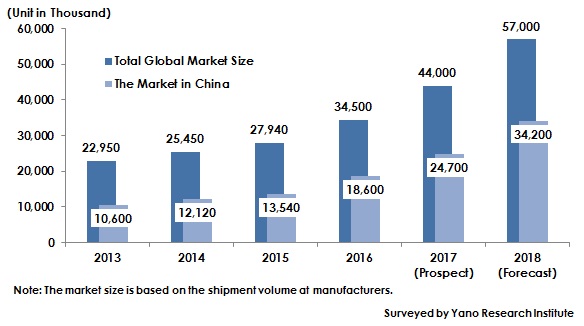No.1868
Global Surveillance Camera Market: Key Research Findings 2018
Global Surveillance Camera Market: Key Research Findings 2018
Yano Research Institute (the President, Takashi Mizukoshi) has surveyed the global markets of surveillance/monitoring cameras by region (Japan, Europe, North America, China, Asia, Mideast, and others) and has clarified the trends of leading camera makers and the next-generation technologies including IP cameras, high-definition (HD) resolutions, remote maintenance supports, and cloud camera services, as well as the future outlook of the market.

Market Overview
The global market size of surveillance cameras in 2017, based on the shipment volume at manufacturers, is projected to attain 44,000 thousand cameras, 127.5% of the size of the previous year, keeping the favorable growth. Especially, for the past couple of years, expansion of the market in China has boosted the entire global market.
Noteworthy Topics
Price Fall Led Surveillance Cameras to be Included in Solutions Business
While the market is expanding, the price of surveillance cameras has been declining significantly. It has dropped by 5% to 10% during the past couple of years. Therefore, it can be said that the era has come for surveillance cameras being unable to secure profits solely. In such a status, the leading camera makers in Japan, US, Europe and South Korea have prominently shifted to promote surveillance cameras by means of so-called solutions business. Therefore, they have started proposing “value-added business”, “the business solutions to include surveillance cameras in an entire system”, “enhancement of image analysis”, “to utilize the cameras within a marketing strategy”, “expansion of the business solutions through facial recognition and room-access management systems”, and etc.
Future Outlook
Currently, majority of the global market share of surveillance cameras is occupied by China, with some Chinese enterprises ranked in the upper positions in the market. In order for the leading companies in Japan, US, Europe and South Korea to survive, they have taken a countermeasure by adding new functions such as higher resolution for clipped-out images and finding out the efficient route for a certain human being to act, which have become available in 2014 when multidirectional cameras were dawning. 2017 can be said as a dawning period of 4K surveillance, as the cameras have become used for wide-range surveillance as well as for the images to be clipped out and divided. In the future, by being associated with various types of sensors, surveillance cameras are expected to be included in M2M (Machine to Machine) and IoT solutions. In terms of software, diverse types can be installed into surveillance cameras for enabling facial recognition, motion analysis, abnormal behavior analysis, and understanding of congestion status, which make the cameras available not only for surveillance but also for marketing and other purposes.
Research Outline
2.Research Object: Manufacturers of surveillance cameras, distributors, Siers, makers of lens, monitoring DVR, and other peripheral devices.
3.Research Methogology: Face-to-face interviews by the specialized researchers, surveys via telephone/email, and literature search
What are Surveillance Cameras?
Surveillance cameras in this research are categorized into two types: IP cameras and analog cameras. IP cameras, a.k.a. network cameras, have IP address to connect solely to the internet, making them utilized for business. Analog cameras, on the other hand, must be physically connected to monitors and recording devices using coaxial cables. Generally speaking, analog cameras are more reasonable in price than IP cameras.
Published Report
Contact Us
The copyright and all other rights pertaining to this report belong to Yano Research Institute.
Please contact our PR team when quoting the report contents for the purpose other than media coverage.
Depending on the purpose of using our report, we may ask you to present your sentences for confirmation beforehand.